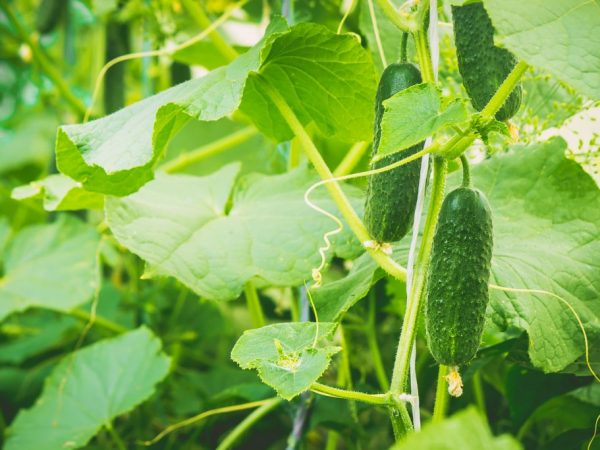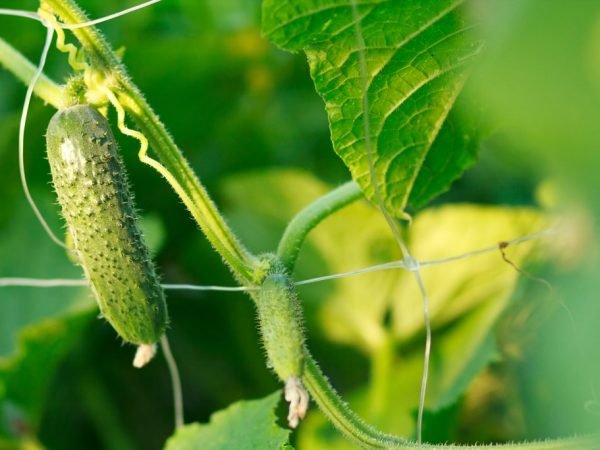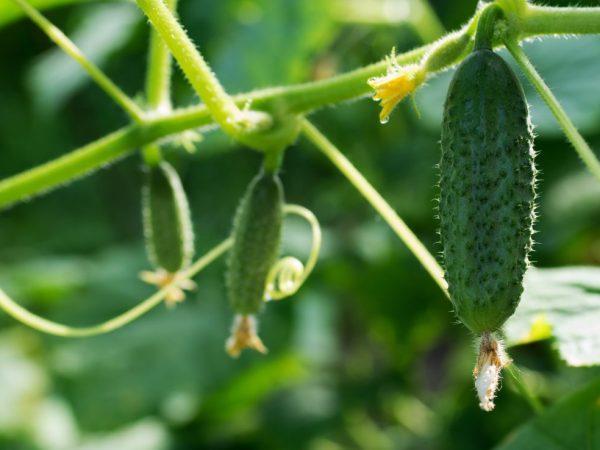Description of varieties of cucumbers with the letter H
Almost all varieties of cucumbers with the letter H belong to hybrid crops. They are popular due to their high resistance to the environment and their good immunity. In the article, consider a detailed description of co-workers.

Description of varieties of cucumbers with the letter H
Miracle at the window
The miracle on the window belongs to the f1 category. This variety is self-pollinated, so it can be grown even in a greenhouse. It is also believed that this houseplant can be grown on a windowsill or balcony.
The growing season of this variety is 40 days from the moment the first shoots appear. The plant is powerful, up to 3 m high. The leafiness is of a moderate type, which greatly facilitates the process of care and harvesting. The flowering type is female. 2-3 ovaries are formed in each node.
The length of the gherkins is 6 cm, and the weight is about 60 g. In the process of ripening they do not acquire a large shape and do not turn yellow at late harvest. Due to their compactness and sweet taste, they are ideal for preservation.
Curly forelock
Cucumber variety Curly Chubchik is an early parthenocarpic species that ripens in 42 days from the moment the first shoots appear. This hybrid is characterized by a female flowering type. The cultivation of this culture is possible both in a greenhouse and in open ground. The height of the bush reaches 2.5 m. Lateral shoots are well developed, their number can reach 8 pieces per bush. In 1 node, 3-5 ovaries are formed at once, which significantly increases the yield of the variety.
The fruits are completely covered with small bumps, on the surface there are rare light stripes that reach only half of the fruit. The length of the fruit is 12 cm, and the weight is about 150 g. It is popular not only when eaten fresh, but also ideal for preservation.
Chernomor
The seeds of this variety of cucumbers are supplied to the world market by the Gavrish company. The variety is ideal for outdoor cultivation, especially in the central or eastern regions of the country. The Chernomor hybrid of category f1 belongs to parnenocarpic crops, pollination by bees is optional.
Bushes can reach 3.5 m. The female type of flowering prevails.
On the surface of the fruit, you can see rare light stripes, reaching only half. There is a fine pubescence of a dark shade. The length of the fruit is 5-7 cm, and the weight is about 80 g. This variety is suitable not only for fresh consumption, but also for pickles.
Clean ponds
Cucumber seeds Chistye Prudy are supplied by Semko. This is a fairly productive variety that ripens in the shortest period of time.
The growing season is about 35 days from the moment the first shoots appear. The flowering type is female. The fruits ripen together, and fruiting lasts until the frost. You can grow a crop both in the greenhouse and in the open field. In 1 node, it is possible to form several ovaries at once, the number of which can reach 5-7 pcs.
The fruits are quite large.Their length can reach 15 cm, and their weight is about 200 g. The hybrid is resistant to most diseases.
Cheboksarets

The variety has a good taste.
Cheboksarets belongs to parnecarpic cultures, with an average bush height and a combined type of flowering. On average, the weight of the bush is about 2 m. The growing season lasts for 40 days, from the moment the first shoots appear. Lateral shoots are rarely formed.
Each node is formed from 3 to 5 ovaries. A few weeks later, at least 3 fruits ripen in this place. Foliage of moderate size, rich green color with slight wrinkles on the surface.
The entire surface of zelents is covered with small frequent thorns and light pubescence. The fruit reaches a length of 12 cm, and its weight is about 100 g. When cut, the diameter is about 4 cm. The taste is quite high quality, which makes this variety of cucumbers universal in use.
Champion
The popular company Sedek, in the past few years, has begun to actively release seeds of the Champion F1 cucumber variety on the world market. It can be grown in open ground and greenhouse conditions. The growing season is about 60 days. Does not need pollination.
Due to the low growth of the bush, about 1.5 m, the care of the plant and the harvesting process are facilitated. The leaves are large, dark green in color and completely covered with slight pubescence.
The fruits are characterized by their green color, size and versatility. The description indicates that the length of the zelents is 10 cm and the weight is about 160 g. The yield is of high quality. From 1m2, you can collect at least 20 kg of high quality products.
Chupa Chups
Cucumber variety Chupa-Shchups, another name Chupa-chups, is supplied by Gavrish to the world market.
This variety belongs to medium early crops. Chupa-Shchups ripens in 48 days, from the moment the first shoots appear. Pollination is not required, so it can be grown even in a greenhouse.
The fruits of the Chupa-Chups variety are not large. Their length is 5 cm, and their cross-sectional diameter is 4 cm. The pulp is juicy, sweet, crunchy. Due to their compactness, they are suitable for preserving as a whole or preparing fresh salads.
Tchaikovsky
Cucumber Tchaikovsky f1 was developed in Holland.
As the description of the Tchaikovsky f1 cucumber variety shows, cucumbers have high yields. The growing season lasts 40 days. The yield is 50 kg per hectare. It has a developed root system and a rather sprawling bush. Even with negative environmental factors, side shoots and stems can regenerate.
The height of the bush is 3 m. Therefore, it definitely needs support and a garter. In each node, 5-7 ovaries can be formed at once. Ultimately, it is possible to collect about 5-6 fruits from each node.
This variety belongs to parthenocarpic cultures, therefore it does not need pollination by bees. The description indicates that Tchaikovsky cucumbers ripen together, and fruiting lasts throughout the entire development of the bush.

The fruits of this variety are universal.
Characteristics of Tchaikovsky cucumbers:
- the length of the greenery is 10-14 cm;
- fruits can reach a weight of 120-140 g;
- the diameter of the fruit is about 5 cm;
The flesh of the Tchaikovsky cucumber is juicy, but not watery. There is a high sugar level, with a slight acidity. There is no bitterness at the genetic level. Products can be consumed both fresh and used for preservation or pickles.
Features of growing hybrids
As practice shows, most of the seeds of hybrid crops do not need disinfection and treatment with growth stimulants. All these preparatory procedures are carried out by a company that supplies seeds to the world market. As a rule, the cultivation of the culture is carried out by the seedling method.If you plant seeds directly into the soil, then the harvest dates come much later.
First you need to plant seeds and get seedlings. For these purposes, it is better to use individual containers for each seed. This is done in order to reduce the risk of root injury when diving. For better seed germination, they need to be planted in the spring season (preferably in early March) and kept at a temperature of 15-18 ° C. It is recommended to constantly turn the container in different directions towards the light source. This will allow the seedlings to form evenly.
As soon as the first pair of petals has formed on the seedlings, you can plant in a permanent place. But, it is necessary for the soil temperature to warm up to 15-17 ° C. Otherwise, the root system may die. If planting is carried out in open ground, then you need to adhere to the 40x50 cm system.If planting is carried out in a greenhouse, then the planting scheme is 50x60 cm.
Care rules
Timely and high-quality watering is important: once every 3-4 days and only with warm water. It is water at room temperature that the plant assimilates best of all.
Top dressing should be carried out three times during the entire growing season of the plant.
- The first subcortex, a week after transplantation to a permanent place, is carried out with the help of potassium substances.
- The second feeding, from the moment the ovaries are formed, consists in the use of phosphorus fertilizers.
- The third feeding is carried out at the moment when fruiting has just begun. At this point, it is advisable to use humus or bird droppings.
You need to loosen the soil and remove weeds regularly. This will only increase the amount of yield and prevent deformation of the bush. You should also tie up the bushes so that they do not break off from the wind or large fruits.
Diseases and parasites
Hybrid varieties are resistant to more diseases: powdery mildew, root rot, brown and olive spot. Therefore, it is not necessary to prevent these diseases.
Are exposed to spider mites, aphids, or the Colorado potato beetle. There are measures to combat each of these parasites. You can prevent the appearance of a tick if weeds are removed in time. And you can fight them with a solution of cayenne pepper. You can get rid of aphids with the help of a copper-containing drug Oxyhom. And in the fight against the Colorado potato beetle, the Regent or Fofatox will come to the rescue.
Conclusion
Almost all hybrids are characterized by high quality indicators. It is for this reason that every gardener wants to grow them on his site. First, you can spend less time and effort on grooming. And secondly, even with minimal care, the yield will be high.


